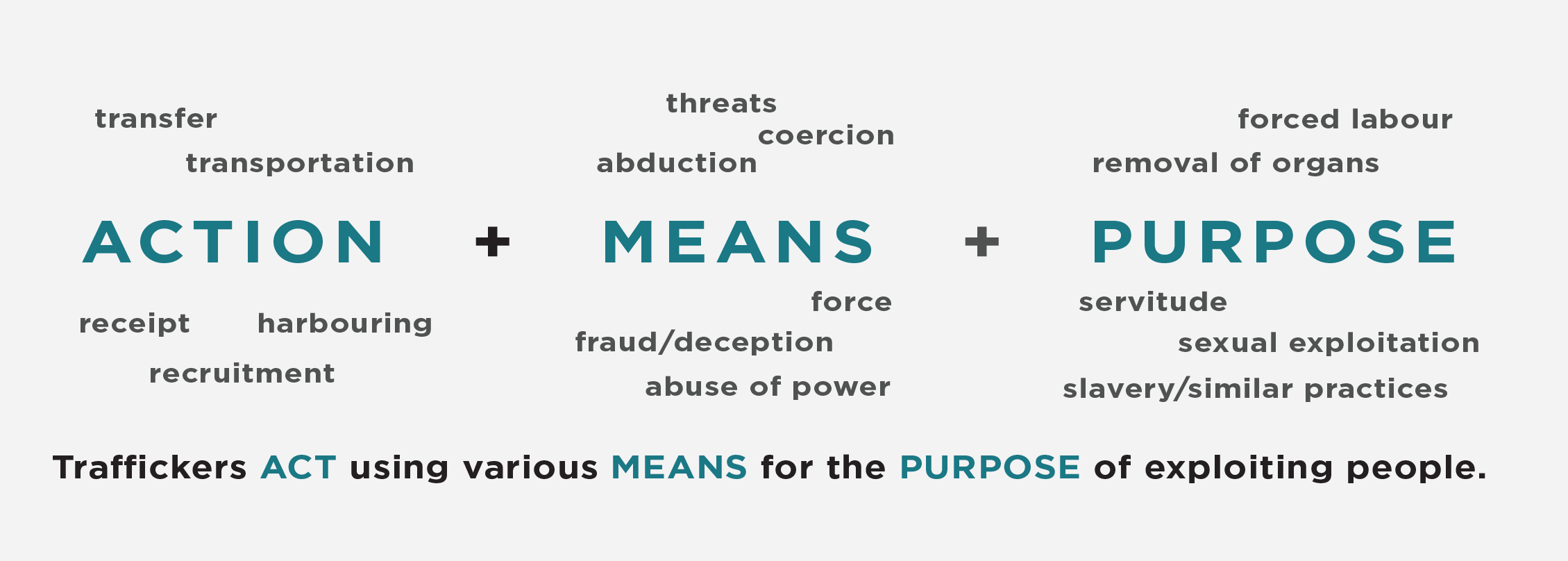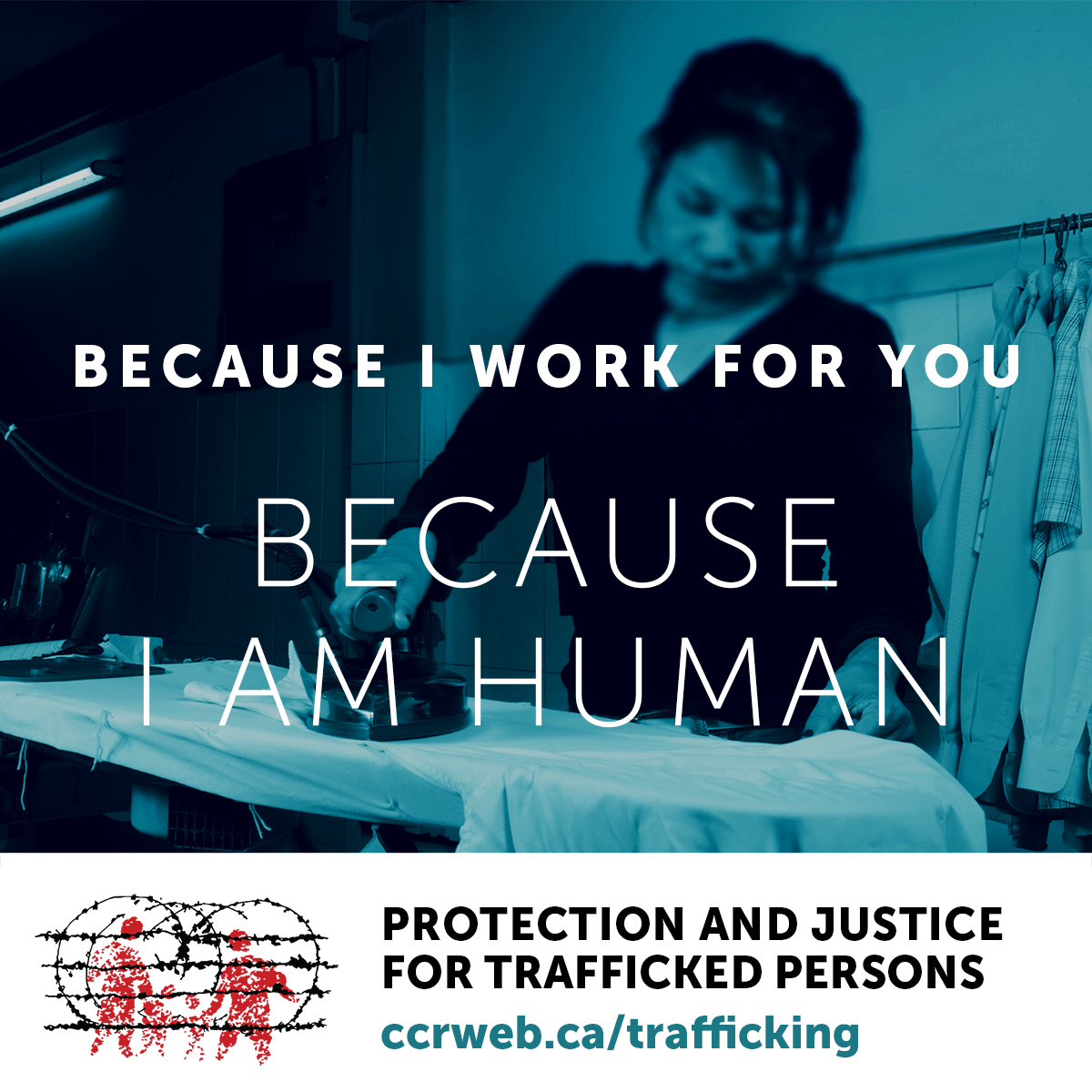Trafficking in Persons for Forced Labour: Backgrounder
Introduction: Trafficking in persons
Trafficking in persons occurs when someone obtains a profit from the exploitation of another person by using some form of coercion, deception or fraud. Exploitation can take many different forms, including through forced labour in various areas such as the service, manufacturing, agricultural or construction sectors, through domestic work, and through work in the sex industry/prostitution. Regardless of the form of exploitation, trafficking in persons is a violation of a person’s basic human rights and it affects men, women and children.
This document aims to give information about how trafficking for labour exploitation can take place in Canada.
Global context: Trafficking for forced labour
 Trafficking for forced labour happens in a context of both global and local economic inequalities where many people are looking for ways to better protect and provide for themselves and their families.
Trafficking for forced labour happens in a context of both global and local economic inequalities where many people are looking for ways to better protect and provide for themselves and their families.
Around the world, approximately 21 million people are in a situation of forced labour. Most of these individuals are exploited by private individuals or businesses. A minority of people are forced to work by state entities. Women are overrepresented among forced labourers globally.[1]
Root causes of trafficking are often socio-economic or political. Poverty, conflicts, inequalities (including based on gender) and persecution are among the common contexts. While many people find themselves in situations of forced labour in their home communities, these root causes often push people to migrate in search of opportunities.
Increasingly restrictive immigration rules worldwide make it more difficult for people to migrate safely and make many migrants more vulnerable. Traffickers take advantage of these situations by exploiting the very limited options and lack of legal and social protections that are available to migrants.
Forms of labour trafficking
 Trafficking for the purpose of labour exploitation takes place when some means (including taking advantage of a person’s particular vulnerabilities) are used as a way of controlling someone in order to cause them to believe that they have no choice but to carry out a specific work or service.
Trafficking for the purpose of labour exploitation takes place when some means (including taking advantage of a person’s particular vulnerabilities) are used as a way of controlling someone in order to cause them to believe that they have no choice but to carry out a specific work or service.
The following shows what the various elements involved in labour trafficking might look like concretely.
An action whereby a person is:
- Recruited by an individual or organization, and often charged large fees and persuaded to take on a large debt in order to get a job;
- Moved from a country to another (or within a country).
A means whereby a person:
- Is deceived through attractive promises (such as a good job or educational or other opportunities) only to find that the promises are false or that conditions (such as work and pay) are much worse than advertised;
- Is isolated in order to control her/his freedom of movement and ability to contact other people, including family and other members of society, and is constantly monitored;
- Is intimidated by threats of being underpaid, not being paid at all, or having penalties deducted; by threats of physical violence, denunciation to authorities and deportation; and through harassment in order to control the person and ensure that they comply;
- Has her/his passport, identity documents and work permit taken from them;
- Has her/his specific vulnerabilities taken advantage of, including a person’s lack of viable economic or employment options, a situation of indebtedness, language barriers, or a person’s separation from loved ones and from her/his support networks.
- Is forced to participate in illegal activities such as fraud or stealing, in order to criminalize them as another means of control.
Exploitation, whereby a person is:
- Underpaid, not paid at all, or whose wages are deducted unjustifiably (such as for wildly overpriced housing);
- Forced to work unpaid overtime;
- Charged large, fraudulent recruitment fees;
- Manipulated into a situation of debt through a loan, wage advance or fraudulent fees charged to keep the person under control and in a situation of bonded labour;
- Sold to different employers by recruiters or agents.
The people involved are not always just the employer or recruiter: acquaintances, neighbours and family members can also play a role.
Labour trafficking in Canada
Migrant workers and labour trafficking
In recent years, Canada has increasingly shifted its focus from permanent to more precarious temporary immigration. More workers are now being brought into Canada on a temporary basis with fewer rights than other workers to fill labour needs. These conditions and the lack of employment options available to them have made migrant workers extremely vulnerable to abuse and exploitation.
Trafficking in persons is the most extreme form of exploitation faced by migrant workers in Canada.
In Canada, trafficking for the purpose of labour has predominantly affected migrant workers. Those most affected by abuse and exploitation often come with valid work permits under the “low-skilled” streams of the Temporary Foreign Workers Program (TFWP), including the Low-wage and Primary Agricultural Streams and the Live-in Caregiver Program. Temporary Foreign Workers employed under these streams may be employed in restaurants, hotels or other hospitality services, on farms, in food preparation, in construction or in manufacturing, as well as in domestic work.
Vulnerabilities of Temporary Foreign Workers to trafficking in persons
The TFWP conditions place migrant workers in a situation where they are vulnerable to exploitation and trafficking. These conditions include:
- Lack of permanent status, putting workers in a precarious situation, with limited protection of their rights or opportunity to complain about mistreatment.
- Employer-specific work permits tie migrant workers’ immigration status to a single employer, causing them to risk deportation if they leave their job. This limits complaints and the prospect of seeking alternative job options in case of mistreatment and unpaid wages.
- Housing is often provided by, shared with, or in Live-in Caregivers’ cases is tied to an employer, making it easier to isolate workers, to extract money through rent, and exploit their labour.
- Physical and social isolation, exacerbated by language barriers that make it difficult to establish community connections.
- Limited access to services.
- No access to language and legal training, education, or federally funded settlement services.
- Lack of monitoring and enforcement, which has made it easier for illegal practices to take place, such as the charging of large recruitment fees, resulting in substantial debt and indentured labour.[2]
Unfortunately, the changes introduced to the TFWP in June 2014 do little to strengthen protection measures for workers. Although some enforcement and monitoring measures have been added, the program continues to rely overwhelmingly on a complaints system that migrant workers are unlikely to use as this can still lead to deportation.
The shift towards more restrictive immigration policies in Canada has also created additional opportunities for people to be trafficked for the purpose of forced labour, by creating additional vulnerabilities that traffickers take advantage of.
Refugee claimants and labour trafficking
Some trafficked persons are forced by their traffickers to make a refugee claim, which is either meant to fail or is not pursued, so that the person is subject to removal. This facilitates traffickers’ ability to threaten and control trafficked persons in order to exploit their labour in different ways.
Recent changes to the Immigration and Refugee Protection Act bar people whose refugee claims have been rejected, withdrawn or abandoned, from applying for status, including the Temporary Resident Permit intended for victims of trafficking.[3] This has made it harder for trafficked persons to escape their traffickers and easier for traffickers to control them through threats of denunciation and deportation.
In 2010, 23 Hungarian men were trafficked to Canada. They were forced to make refugee claims, their documents were taken away and they were made to work on construction sites up to seven days a week without pay and to participate in criminal activities. They were threatened and some were physically assaulted. They were monitored, controlled and forced to live in the basement of their traffickers’ homes.
Had they faced the new legal barriers, they likely would not have received protection in Canada.
Family and domestic situations
Trafficking for forced labour also takes place in situations where a person is forced into domestic servitude by family members or by others outside the family. Such cases can include:
 Children forced to work at home or exploited in other ways;
Children forced to work at home or exploited in other ways;- Domestic servants accompanying their employers into Canada, coerced into unpaid labour;
- Spouses, parents or grandparents exploited financially and/or forced to do work inside or outside the home, under threats of violence or deportation. The new Conditional Permanent Residence policy places some sponsored spouses in a more vulnerable position.[4] Forced marriages may also be used as a means to exploit a spouse.[5]
Labour trafficking and precarious immigration status
People with insecure immigration status or no status at all are particularly vulnerable to trafficking for their labour. Whether they enter as a Temporary Foreign Worker, a refugee claimant, a student, a tourist or irregularly, traffickers may take advantage of their limited rights in Canada and the threat of detention and deportation, to force them to carry out work.
Due to changes in immigration policy, more people are in Canada with temporary and precarious status.
Possible solutions
The risk of trafficking can be reduced, and recourses for those who are trafficked improved by:
- Increasing access to permanent status;
- Expanding the rights of those with temporary status and enforcing laws to protect them from abuse;
- Introducing legal protections for trafficked persons without secure immigration status in Canada.
[1] International Labour Organization (ILO) 2012 Global Estimate of Forced Labour: http://bit.ly/1wreu9s.
[2] See Profiting from the Precarious: How recruitment practices exploit migrant workers, Metcalf Foundation, available online: http://bit.ly/QnrPBt.
[3] Canadian Council for Refugees, Access to Protection for Trafficked Non-Citizens: ccrweb.ca/en/protection-trafficked-persons
[4] Canadian Council for Refugees, Conditional Permanent Residence: ccrweb.ca/en/conditional-permanent-residence
[5] See Resource Information Guide to Human Trafficking Systems through Forced Marriages, South Asian Women’s Centre (SAWC): ccrweb.ca/en/resource-information-guide-human-trafficking-forced-marriages
